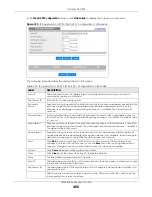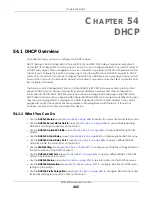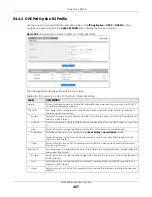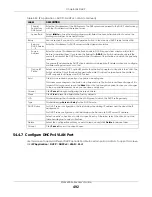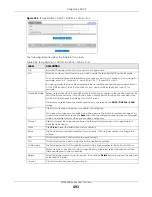
Chapter 53 Differentiated Services
XGS4600 Series User’s Guide
478
C
HAPTER
53
Differentiated Services
53.1 DiffServ Overview
This chapter shows you how to configure Differentiated Services (DiffServ) on the Switch.
Quality of Service (QoS) is used to prioritize source-to-destination traffic flows. All packets in the flow are
given the same priority. You can use CoS (class of service) to give different priorities to different packet
types.
DiffServ is a class of service (CoS) model that marks packets so that they receive specific per-hop
treatment at DiffServ-compliant network devices along the route based on the application types and
traffic flow. Packets are marked with DiffServ Code Points (DSCPs) indicating the level of service desired.
This allows the intermediary DiffServ-compliant network devices to handle the packets differently
depending on the code points without the need to negotiate paths or remember state information for
every flow. In addition, applications do not have to request a particular service or give advanced
notice of where the traffic is going.
53.1.1 What You Can Do
• Use the
DiffServ
screen (
) to activate DiffServ to apply marking rules or IEEE
802.1p priority mapping on the Switch.
• Use the
DSCP
Setting
screen (
) to change the DSCP-IEEE 802.1p mapping.
53.1.2 What You Need to Know
Read on for concepts on Differentiated Services that can help you configure the screens in this chapter.
DSCP and Per-Hop Behavior
DiffServ defines a new DS (Differentiated Services) field to replace the Type of Service (ToS) field in the IP
header. The DS field contains a 6-bit DSCP field which can define up to 64 service levels and the
remaining 2 bits are defined as currently unused (CU). The following figure illustrates the DS field.
Figure 381
DiffServ: Differentiated Service Field
DSCP is backward compatible with the three precedence bits in the ToS octet so that non-DiffServ
compliant, ToS-enabled network device will not conflict with the DSCP mapping.
The DSCP value determines the PHB (Per-Hop Behavior), that each packet gets as it is forwarded across
the DiffServ network. Based on the marking rule different kinds of traffic can be marked for different
DSCP (6 bits)
CU (2 bits)
Содержание XGS4600 Series
Страница 24: ...24 PART I User s Guide ...
Страница 44: ...44 PART II Technical Reference ...
Страница 180: ...Chapter 13 Spanning Tree Protocol XGS4600 Series User s Guide 180 Figure 145 MSTP and Legacy RSTP Network Example ...
Страница 189: ...Chapter 16 Mirroring XGS4600 Series User s Guide 189 Figure 150 Advanced Application Mirroring Standalone Mode ...
Страница 244: ...Chapter 22 Policy Rule XGS4600 Series User s Guide 244 Figure 189 Policy Example EXAMPLE ...
Страница 277: ...Chapter 25 Multicast XGS4600 Series User s Guide 277 Figure 215 Advanced Application Multicast MVR Standalone Mode ...
Страница 559: ...Chapter 59 Access Control XGS4600 Series User s Guide 559 Figure 460 Example Lock Denoting a Secure Connection EXAMPLE ...
Страница 586: ...Chapter 69 Configure Clone XGS4600 Series User s Guide 586 Figure 479 Management Configure Clone Standalone Mode ...
Страница 587: ...Chapter 69 Configure Clone XGS4600 Series User s Guide 587 Figure 480 Management Configure Clone Stacking Mode ...
Страница 594: ...Chapter 71 Port Status XGS4600 Series User s Guide 594 Figure 485 Management Port Status Port Details Standalone Mode ...
Страница 604: ...604 PART III Troubleshooting and Appendices ...





